BOSTON, March 21 (UPI) -- Astronomers have struggled to identify the origins of the heaviest elements, like gold and lead. A tiny, ancient galaxy may offer clues.
The Big Bang produced the lightest elements on the periodic table, while heavier elements were forged by stellar fusion and supernovas. Now, astronomers think the heaviest elements are created by collisions between neutron stars.















